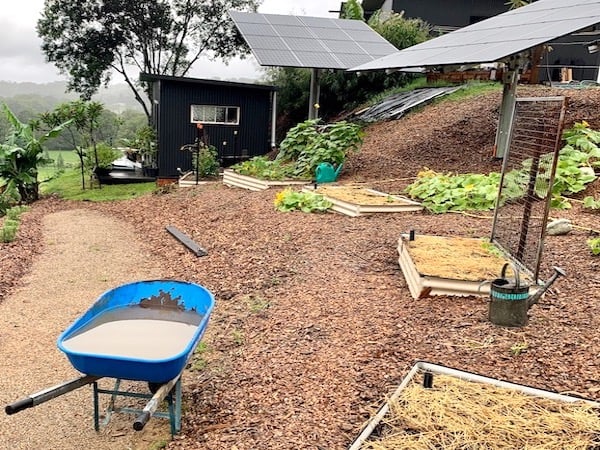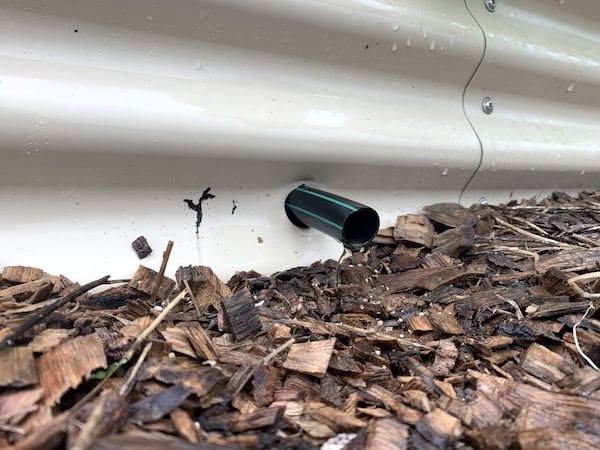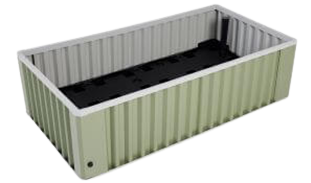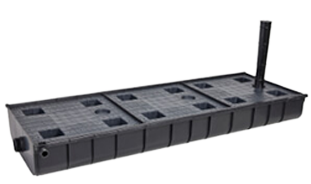

Wicking Beds perform well in the rain
Posted on: 9 March 2020 by Ian Collins
Up until a couple of weeks ago our focus on wicking beds has been on how well they performed in times of drought. Rain has long been our absent friend. However, with the recent heavy rains, particularly along the east coast of Australia, I thought that it would be useful to observe how wicking beds have performed in the wet.
Our observations have been:-
- The water reservoirs on all of our beds are now full, with the wicking beds acting as small supplementary rainwater tanks;
- Overflow pipes have been effective in expelling surplus water with the soil moisture levels quickly normalising towards ‘Field Capacity’;
- By way of comparison, some non-wicking planters and raised beds have had difficulty in discharging surplus water and remained water logged with a negative impact on plants;
- Some mulches have performed better than others in allowing water to penetrate.
Wicking Beds act as water tanks
Capturing and reusing rainwater is a goal of most gardeners, particularly those in areas of intermittent rainfall. Wicking beds are a great water retention resource. The reservoirs in WaterUps® wicking beds hold 120L of water per square metre, or just under 20L per cell.
This prompted me to wonder how much rain it would take to fill up a WaterUps® wicking bed? If it is completely empty, you will need approximately 120mm of rain per square metre of wicking bed area. Another way of looking at this is, for every 30mm of rain, the water capacity of your reservoir is extended by approximately 1 week.
On a cautionary note, wicking beds should definitely not be kept full. They should be allowed to empty almost fully before refilling in order to allow aeration of the soil.
Efficiency of Overflow Pipes in Wicking Beds
Overflow pipes are an essential component of wicking beds. When correctly positioned they ensure that surplus water flows out, thereby preventing the soil from becoming water logged and anaerobic. The 10mm internal diameter of the WaterUps® overflow pipe has the capacity expel 108 litres of water per hour. With heavy rain, which is classed as in excess of 8mm per hour, you would roughly need 1 overflow pipe for at least every 10.8 square metres of wicking bed area to effectively ensure that your soil does not become water logged. We would probably recommend one for every 8 square metres to be on the safe side.
Non-Wicking Beds
Gardeners with non-wicking beds are generally not focused on the importance of drainage and the problem of excess water. Raised beds should have no drainage problems unless they sit on a very clay dominated base. Usually the problem with raised beds is their inability to retain water and soil nutrients, rather than getting water logged. Gardeners using planter tubs or pots can, however, often find that they are prone to getting water logged during heavy rain. This is because over time the overflow hole at the base of the tub becomes less effective due to it being clogged with plant roots or compacted soil.
Effectiveness of Different Mulches
I touched on the subject of mulch in a blog back in October last year, when I looked at ways of protecting the contents of your wicking bed from the ravages of hot dry summers. Ironically, the recent heavy rains on the east coast of Australia have again prompted me to look at how various mulches have performed. Looking at the beds at our research farm at Bilinudgel and at my beds in Sydney, we have found that some mulches have performed much better than others in absorbing the rain water. While working well in limiting evaporation, and as insulators of the soil in the summer heat, some mulches didn’t perform that well when it came to allowing the heavy rain water to penetrate. With some of the finer mulches in particular, the rainwater largely ran off and didn’t penetrate the soil below to any great extent. Hydrophobic mulch after over 300mm of rain is not good!
This got me thinking again about mulch, its function in the garden, and why we use it. Apart from the obvious function of changing the aesthetics of your garden, mulch has a number of benefits in improving the soil microbiology. Garden mulch should perform the following functions:
- Improve soil structure
- Assist water transfer to the soil and limit evaporation
- Moderate soil temperature
- Help prevent erosion
- Add nutrients and humus to the soil
- Suppress pathogens and pests by increasing biodiversity
- Help prevent the proliferation of weeds
Wood Chip Mulch in Wicking Beds
A closer investigation of the various mulches that we have used, showed that the best performers, when it came to water transfer, were the courser mulches with non-uniform particle sizes. We have found that wood chips actually performed best as a mulch in allowing the rainwater to penetrate and that the finer mulches actually had a tendency to matt together and become hydrophobic over time. This was the case with sugarcane and pea straw and lucerne mulches that had been left undisturbed.
Wood chip mulch has been the subject of various studies and some conjecture. While most experts seem happy with wood chip mulches for trees and deep rooting shrubs, there is considerable debate about whether it is suitable for vegetable gardens. Some argue that wood chip mulches can create a thin zone of nitrogen loss where the wood chips touch the soil, which can negatively impact the health of very shallow rooting vegetables. There is still some debate about this, however, with some scientists actually arguing that “over time, nitrogen levels in the soil increased in the areas where wood chips were used as a mulch” [1]. The main authority on wood chip mulches seems to be Dr. Linda Chalker-Scott and her conclusion is that the nitrogen drawdown effect is largely a myth.
Mark Smith from Adelaide Hills Vegie Gardens, who is our WaterUps® stockist in Adelaide, actually eliminates the potential for any nitrogen draw down issue to occur by using a mix of coarse wood chips and composted chicken bedding, containing chicken manure. He uses a product called ‘Who Flung Dung’ and says he’s “used it for the past few years and the results are brilliant. The plants are fed as well as getting all the other benefits of a coarse mulch.”
I have also read comments that wood chip mulch can cause soil to become acidic, but this does not seem to be supported by scientific evidence.
Well, I am going to try some forest fines wood chip mulch in some of my veggie beds and some ‘Who Flung Dung’ for comparison and see how they go! I’ll report back with my findings.
Footnotes
- Brian Caldwell, “Wood Chips in Vegetable Production”




